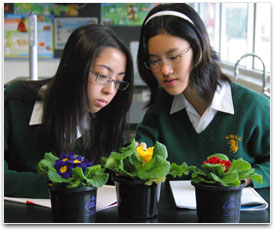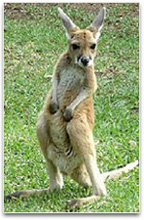what are genes and why are they important to the production of plant and animals
This focus thought is explored through:
Contrasting student and scientific views
Student everyday experiences
 Students commonly bring ideas of genetics from 'folklore': means in which families describe what and how certain characteristics are inherited. Their ideas can be further confused via popular reporting of genetics in the media.
Students commonly bring ideas of genetics from 'folklore': means in which families describe what and how certain characteristics are inherited. Their ideas can be further confused via popular reporting of genetics in the media.
Examples of these conceptions include:
- that whatsoever observable variation between organisms of the same species is solely due to environmental factors
- that not all living things incorporate genetic data
- that a factor is not a real thing
- that genes that carry the genetic cloth are only plant in the blood or simply found in the brain or merely constitute in the reproductive organization
- that a person will only bear genes for characteristics they display (such as tongue rolling) and non for characteristics that they exercise non brandish (such every bit cerise hair)
- that acquired changes (eastward.m. muscle development) can exist passed onto offspring
- that genetic inheritance involves an averaging of the genes from both parents (east.g. night pare and white skin leads to brown peel) and so each of a kid'south characteristics is somewhere in betwixt those of the parents.
Research: Driver, Squires, Rushworth & Wood-Robinson (1994), Lewis, Leach & Forest-Robinson (2000)
Widespread confusion exists amidst students between the concept of inherited changes in populations that have place over large periods of time (generations) and that of not inherited changes in individual organisms that take place over the flow of the organism'southward lifetime.
Research: Lewis, Leach & Forest-Robinson (2000)
Scientific view
Genetic fabric, including genes and Deoxyribonucleic acid, controls the development, maintenance and reproduction of organisms.
Genetic information is passed from generation to generation through inherited units of chemical information (in well-nigh cases, genes). Organisms produce other similar organisms through sexual reproduction, which allows the line of genetic material to exist maintained and generations to be linked. Through reproduction, organisms in a species maintain a 'depository financial institution' of genetic information which links private members and successive generations.
Variations in characteristics, such equally peel or hair colour, issue from the population containing a range of genetic information for the feature. Characteristics that are not seen may be carried in genetic information (recessive) past individuals and can be passed on. This means that offspring may display characteristics different from their parents. The feature that is observed may exist controlled past a number of genes. At that place are a large number of possible combinations of genes from both parents. The characteristics of the offspring need not be an intermediate of the ii parents.
Organisms possess genetic material that contains information for the evolution of characteristics. This material passes from 1 generation to the next through reproduction.
All plants and animals are made up of cells where the genetic material can exist plant in the form of genes and chromosomes (usually in the nucleus).
Research: Lewis, Leach & Woods-Robinson (1999)
Changes that accept place in an organism over its lifetime (for instance, darkening of human skin due to exposure to sunlight) commonly accept no event on the organism's genetic makeup and because of this volition not exist passed on to the organism's offspring. Changes to an organism that are a result of or result in genetic mutation change the genetic makeup of an organism and can be passed on to the next generation.
Research: Wood-Robinson (1994)
Mutations are changes in an organism's genetic information that potentially impact the current functioning of that genetic data.
Critical instruction ideas
- Genetic material provides the information that allows living things to function.
- Genetic information tin be passed on from generation to generation. The passing on of this genetic data will be dissimilar in asexual and sexual reproduction and cloning. Variations within this information are more likely in sexual reproduction.
- Changes in genetic information (for example, from mutation) can requite rise to variation in characteristics and can be passed on through the generations.
Explore the relationships between ideas about genetic information ideas in the Concept Evolution Maps – (Variation in Inherited Characteristics, Jail cell Functions, Dna and Inherited Characteristics, Natural Pick, Cells and Organs).
Students need to realise that genetic material is establish in all living things and it carries information that directs the organism's functioning.
By studying reproduction students should develop an understanding that genetic data is passed from one generation to another via organised chemical structures.
Students demand to study examples of changes in genetic information that can ascend due to mutation. They should also study the touch on of caused changes on organisms and develop an agreement that these changes are not inherited because they are not created by genetic changes.
For organisms to survive it is important that the information needed for survival is passed on through the generations. If a population has sufficient variation within its genetic information, information technology is more probable to reply successfully to changes in the environs. Mutations tin assistance past increasing the variation.
Educational activity activities
Collect evidence/information for assay
Students could be given a group of organisms and asked to track the variations that have occurred in that species. For case, for tiger snakes in Australia, one species has developed into 6 private species:
- Notechis scutatus (Common Tiger Ophidian)
- Notechis ater ater (Krefft's Tiger Snake)
- Notechis ater niger ( Peninsula Tiger Snake)
- Notechis ater occidentalis (Western Tiger Snake)
- Notechis ater serventyi (Chappell Island Tiger Serpent)
- Notechis ater humphreysi (Tasmanian and Rex Island Tiger Snakes).
Clarify and consolidate ideas for/by advice to others
 The students could and then comment on how this variation has enhanced the chances of survival in different environments and contributed to changes in a pool of genetic information.
The students could and then comment on how this variation has enhanced the chances of survival in different environments and contributed to changes in a pool of genetic information.
Students could create their ain 'David Attenborough' type documentary. They could pick an organism to investigate; local examples might be frogs, dogs, kangaroos, fungi or birds. They could also choose to create a documentary nearly plants including those that have been genetically modified for food. For ideas on how to carry out this type of action the students could watch videos such every bit David Attenborough documentaries.
Promote reflection on and clarification of existing ideas
Another action might be for the students to design high tech genetic identity cards; for this students may demand to research the possible ethical and human rights considerations of collecting this personal information. They would also demand to consider whether sure drugs would exist able to modify genetic information and how this data would be recorded on the identity cards.
Students might as well produce identity kits which would include family information, photographs and family background. This could lead to discussion on who would have access to these and why they would need that access.
Collect show/data for analysis
Students should use a diverseness of visual images to collect and draw data about the changes that can occur within and between organisms. They would need to enquiry using books, journals and the net, and then analyse their research to produce their findings.
Promote reflection on and description of existing ideas
Students might also talk over the causes and sources of mutations also as other sources of variation (such as recombination). They will also need to discuss and analyse the ethical aspects of genetics and how these impact on humans.
Open discussion by a shared experience
Ethical issues and dilemmas associated with genetics can elicit educatee need to know and provide first-class routes into student engagement.
A useful resource to explore the role of the sickle cell factor in natural choice is:
- A Mutation Story
Source: https://www.education.vic.gov.au/school/teachers/teachingresources/discipline/science/continuum/Pages/geneticinfo.aspx
0 Response to "what are genes and why are they important to the production of plant and animals"
Post a Comment